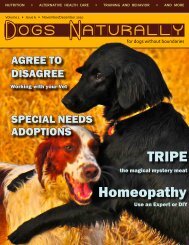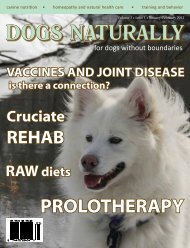For Dogs Without Boundaries - Dogs Naturally Magazine
For Dogs Without Boundaries - Dogs Naturally Magazine
For Dogs Without Boundaries - Dogs Naturally Magazine
You also want an ePaper? Increase the reach of your titles
YUMPU automatically turns print PDFs into web optimized ePapers that Google loves.
NILIF<br />
The “Nothing In Life Is Free” program, when implemented<br />
in a reasonable manner, can greatly help increase the odds<br />
of good behavior. When the dog learns that the way to get<br />
what he wants is by doing something you like, your dog will<br />
start doing what you like more often. This program also<br />
helps teach the dog the concept of self-control. If mugging<br />
you for food works, why should he sit politely during<br />
meals If pulling on the leash works, why should he try to<br />
keep the leash loose But, if the dog has to sit before he gets<br />
a treat and has to keep the leash loose before you are willing<br />
to move a single step, he has more reason to try selfcontrol.<br />
This program goes hand in hand with helping the<br />
dog toward an acceptable behavior and then rewarding that<br />
behavior with something the dog wants.<br />
Look for the Good<br />
We are a punishing species. It is a proven fact that when a<br />
person uses punishment and it gets results, the use of punishment<br />
is more likely. However, the same can be said of<br />
using rewarding methods. If you are watching for behaviors<br />
you can reward (& you reward them) those behaviors<br />
will become more frequent. This works better than always<br />
looking for what the dog is doing wrong so you can yell or<br />
jerk on the leash. The punishment method will cause a dog<br />
to hide the behavior from you. The reward method will<br />
cause the dog to bond with you because he wants to figure<br />
out what you want him to do (so he can get what he wants.)<br />
<strong>For</strong> some complex behaviors, you might need to gradually<br />
“shape” the behavior of the dog to get it closer and closer to<br />
the desired behavior. You can do this by timing your rewards<br />
in a way that keeps the dog trying and moving toward<br />
the desired behavior.<br />
Be Active<br />
Most dogs do not get the exercise they require. Many are<br />
over weight and bored out of their minds. By keeping their<br />
mind and body active, the dog will have less time to get<br />
himself into trouble by creating his own fun games- like<br />
let’s see how many springs are inside the bed. This troop<br />
website has many suggestions for keeping dogs busy both<br />
with and without the owner present.<br />
Don’t Mix Signals<br />
As humans, we communicate primarily with words. <strong>Dogs</strong>,<br />
however, are best at reading non-verbal signals like body<br />
language and tone of voice. We also tend to use our words<br />
in a confusing way- saying “down” when we mean “get off”<br />
and repeating the cue so fast it becomes a new cue ("sit, sit,<br />
sit".) Now the dog waits to hear “sit-sit-sit” before he responds.<br />
Our message and tone can be confusing too. Saying<br />
“come here!” in a ruff and growly voice does not indicate to<br />
the dog that going toward you will be safe. Dog’s are masters<br />
at reading our body language. Even subtle changes like<br />
breathing patterns and raised eye brows are often noticed<br />
by dogs. Be aware of what you are saying with your tone<br />
and body to be sure it’s not confusing the dog. If your dog is<br />
not correctly responding to what you ask, check to make<br />
sure your body language and tone aren't asking for something<br />
different (or indicating a bad mood that could make<br />
the dog hesitant to respond.)<br />
Train, Train, Train<br />
<strong>Dogs</strong> do not come with “good behavior” naturally. In fact,<br />
most behavior that DOES come naturally to a dog is in direct<br />
contradiction with what we want. By looking for and<br />
rewarding the desired behaviors, and redirecting unwanted<br />
behaviors into ones we can reward, you will be teaching<br />
your dog what you like and expect. Just as with raising a<br />
small child, teaching dogs what will make you happy and<br />
what will upset you is a 24 hour/ 7 days a week job! <strong>Dogs</strong><br />
and children are always learning. You need to make a decision<br />
to be sure they are learning what you want them to<br />
learn.<br />
Love your dog<br />
When the dog is being<br />
bad, this is not always<br />
easy. It is very easy<br />
to get frustrated with<br />
them and perhaps<br />
even want to lash out<br />
at them. When this<br />
happens, take a moment<br />
to take a deep<br />
breath, then assess<br />
the situation. What<br />
can you do to prevent<br />
it What alternative<br />
behavior can you try<br />
to get the dog to do so<br />
you can reward it Is<br />
it a natural behavior<br />
the dog needs an outlet<br />
for Is anyone else<br />
allowing the dog to<br />
practice the unwanted<br />
behavior<br />
Can you use the situation to teach the dog self-control<br />
Does the dog need more exercise Would the dog be doing<br />
this behavior if he was tired Are your desires being communicated<br />
clearly to the dog When you answer these<br />
questions, it is likely that you will have something to work<br />
with. You’ll have a behavior (or more than one) you can<br />
watch for and reward. You will understand how to prevent<br />
the unwanted and reward the good dog.<br />
www.dogsnaturallymagazine.com January/February 2010 | 9












